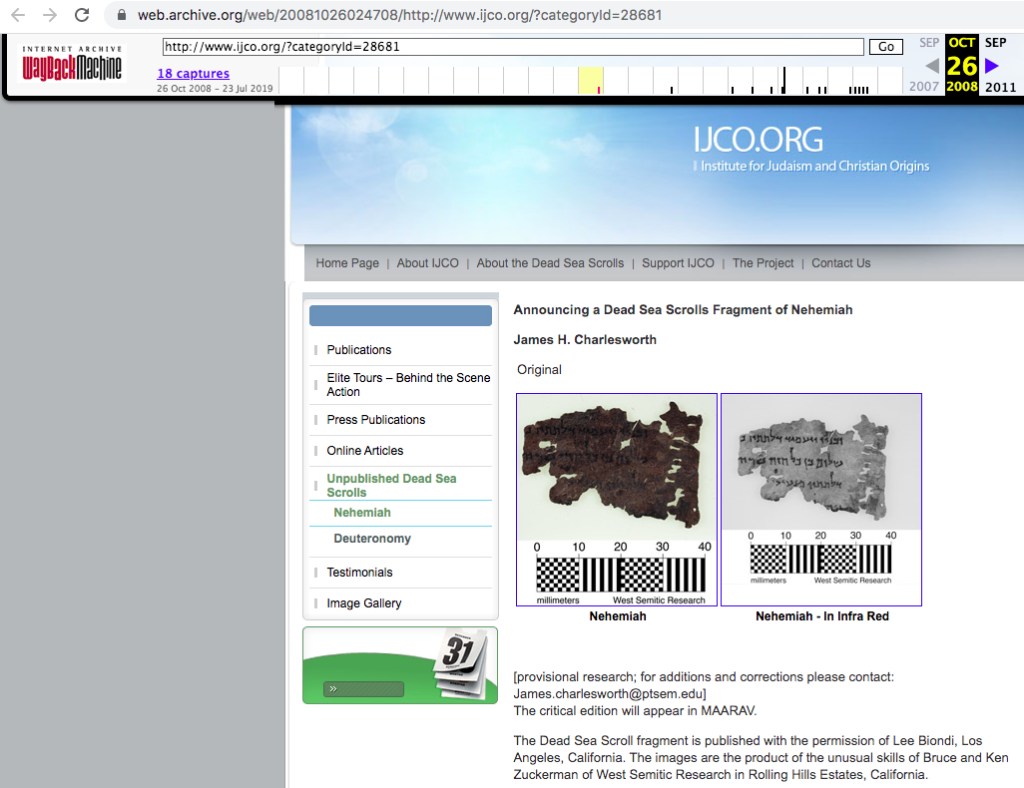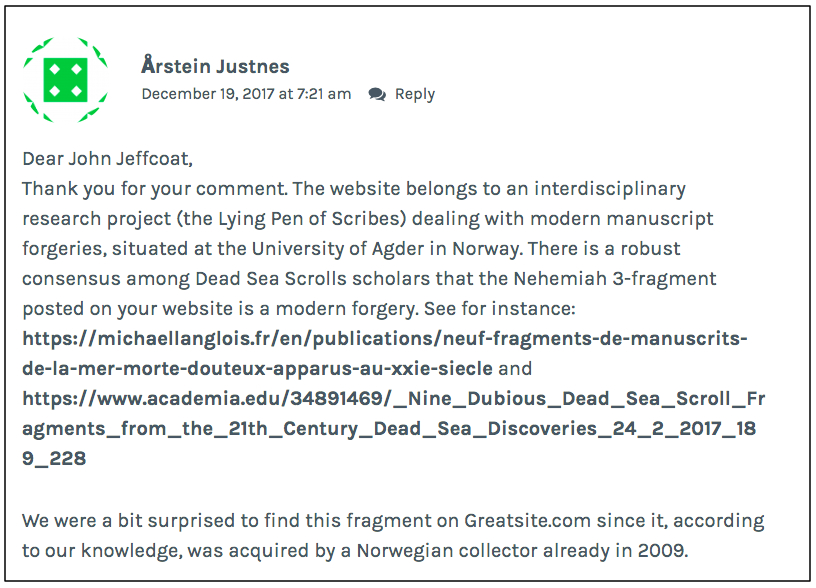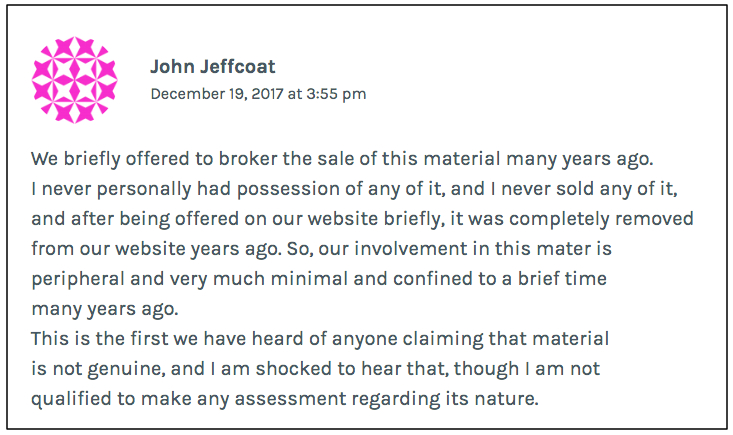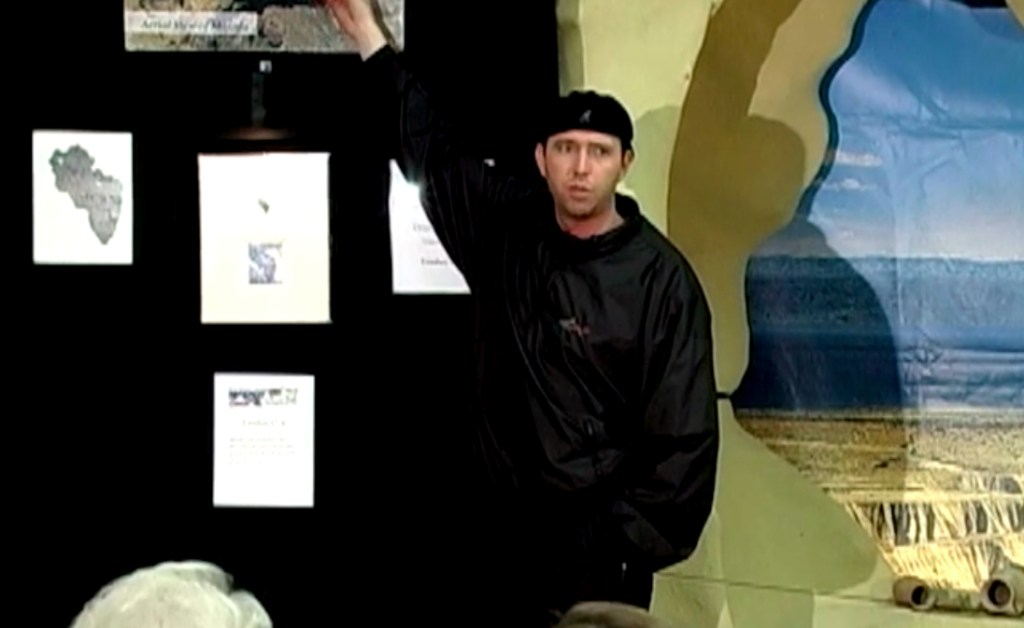Two posts in recent days prompt me to wonder about the cast of characters involved in the marketing of the “post-2002 Dead Sea Scrolls like fragments” that most of the guild now regards as forgeries (though respected Dead Sea Scrolls scholar Emanuel Tov seems to be withholding judgement on that point).
The first post is by Paul Barford, who helpfully reminds us about the Museum of the Bible’s “Objects with Incomplete Provenance” page. Here is a quick summary of the information about the acquisition of their 16 fragments that have now been determined to be fakes:
- Four purchased from Dr. Craig Lampe in November 2009: SCR.000120 (Exodus), SCR.000121 (Psalms), SCR.000122 (Leviticus?), SCR.000123 (Instruction).
- One purchased from Michael Sharpe Rare & Antiquarian Books in February 2010: SCR.000124 (Genesis).
- Seven purchased from William Kando in May 2010: SCR.003170 (Daniel), SCR.003171 (Jonah), SCR.003172 (Jeremiah), SCR.003173 (Numbers), SCR.003174 (Ezekiel), SCR.003175 (Nehemiah), SCR.003183 (Micah).
- Four purchased from Andrew Stimer in October 2014: SCR.004742 (Leviticus), SCR.004741, SCR.004768, and SCR.004769 (the latter three are unidentified and were not included in the Brill volume).
The second post was by Årstein Justnes, who gathered together some early statements about the origins of one of the fake fragments of Genesis. It seems to me that there is a lot of value in exercises like this, pulling together what we know about individual fragments and their recent histories. With some of these fragments, many of the major names of sellers and scholars mix together, with the result that the actual change of ownership is sometimes unclear (who is acting as “owner” and who is a “broker”?). A good example of this is one of the first fragments to be flagged as suspicious, a purportedly ancient fragment containing Neh. 3:14-15 (DSS F. 122, number 41 on the Lying Pen website). Jim Davila expressed skepticism almost immediately after the fragment appeared in 2008 (“one has to wonder about [its] authenticity”).
Much of what follows here is derived from various excellent (and encyclopedic) posts by Ludvik A. Kjeldsberg and Årstein Justnes of the Lying Pen project, so this will be old news to some. But I think there is some value in gathering these links together and thinking a bit about the movements of this forgery.
This fake fragment seems to have first surfaced in 2008, when it was published online in a provisional form by Professor James Charlesworth of Princeton Theological Seminary, who noted the publication was “with the permission of Lee Biondi,” the rare manuscripts dealer based in California who I have mentioned before in connection with Professor Dirk Obbink’s activities on the antiquities market.

Professor Charlesworth said little about the origins of the fragment other than noting that “the one who had the fragment since the sixties reports that it is from Qumran Cave IV.”
At roughly the same time, the fake fragment appeared for sale at Greatsite.com, the online showroom of The Bible Museum (not to be confused with the Museum of the Bible), an online seller of rare books associated with Craig and Joel Lampe:

The provenance information provided on the site was this:
“Provenance:
1. Community of the Essenes, Qumran (circa 30 BC-68 AD)
2. Qumran Cave 4 (A.D. 68-1952)
3. Bedouin discoverers to Khalil Iskander Shahin in Bethlehem
4. Khalil Iskander Shahin to a private collector in France (1953-2004)
[5]. Private collection, Switzerland (2004-2006).
[6]. Purchased and re-conserved by an American dealer in 2006.
The item is guaranteed to be authentic, legally exported from the Middle East in the 1950s and legally imported into the United States.
The item is accompanied by a full scientific and scholarly report.”
There are several interesting features of this description of provenance for this item that is “guaranteed to be authentic.” It would be good to learn the identities of the “private collector” in France,” the “private collection” in Switzerland, and the “American dealer.” And I would be quite curious to see that “scholarly report.” Specifically, I wonder to what degree it resembles the material published online by Professor Charlesworth, whose name shows up further down on the seller’s page:
“This fragment is published online and is scheduled to be published in 2008 by Prof. James Charlesworth of the Princeton Theological Seminary and Head of Princeton’s Dead Sea Scroll project in the academic journal MAARAV: A Journal for the Study of the Northwest Semitic Languages and Literatures. Prof. Charlesworth intends to follow the journal publication with a monograph.”
This impressive set of academic credentials serves as a preface to the sales pitch itself:
“With the understanding that Dead Sea Scroll Fragments have an estimated sale price that is well into six figures if you wish to explore the possibility of obtaining one, just…contact us.”
Early in the following year (2009), the Nehemiah fragment was part of an exhibit in Arizona. It appears on the cover of the exhibition catalog written by Lee Biondi:

All of this points to Biondi as the owner of the fragment, but it is interesting to note that the publisher of the catalog is Legacy Ministries International.

In 2009, Legacy Ministries International (LMI) was the name of an organization now known as Hope Partners International. LMI was itself trading in suspicious Dead Sea Scrolls fragments, several of which it sold to Azusa Pacific University in 2009.

The chairman and chief executive officer was Andrew Stimer. Mr. Stimer, it will be recalled, both sold (fake) Dead Sea Scroll fragments to the Museum of the Bible and purchased (real) early Christian papyri stolen from the Oxyrhynchus collection. So, the group of names somehow connected to this fragment now includes Lee Biondi, James Charlesworth, Craig and Joel Lampe, and Andrew Stimer.
Still in 2009, apparently, the fragment was sold to the Norwegian collector Martin Schøyen (MS 5426). Unless I miss something, the fragment next turns up in 2012 in publicity connected with the forthcoming publication of several “Dead Sea Scroll-like fragments” in the Schøyen Collection:

But when the Schøyen Collection volume appeared in 2016, the Nehemiah fragment was not in it, a point noted by reviewers (link to a pdf file). Did the editors refuse to publish the piece because they regarded it as a forgery?
The answer to that question was forthcoming in the 2017 volume of the journal Dead Sea Discoveries, which contained an article co-written by several people including the editors of the Schøyen volume.

These authors concluded the Nehemiah fragment and eight other “Dead Sea Scroll-like fragments” in the Schøyen Collection were most likely forgeries. I’m unaware of anyone who has come forward to defend the authenticity of the fragment.
It is understandable that in the aftermath of all this, some of the parties involved in the early days have distanced themselves from this fragment. In an exchange from December 2017 in the comments on the Lying Pen site, the owner of Greatsite.com, John Jeffcoat, posed some questions and offered some explanations:



But the Lampe family did have custody of other fragments now widely regarded as fakes (although I have no knowledge of these pieces ever being offered for sale on Greatsite.com). As the information at the beginning of this post indicates, Craig Lampe sold four pieces to the Green Collection. We see some of the fakes on display along with enlarged, enhanced photographs, for instance, in a promotional video, Mysteries of the Dead Sea Scrolls (2006), starring Joel Lampe standing in front of what appears to be a portable Qumran cave (I do not know if either the fragments or the portable Qumran cave were for sale at this event).

I think it worthy of note that some pieces in the video were also featured in the Biondi/Legacy Ministries International catalog, such as the item below, a fragment now owned by the Museum of the Bible and considered a fake containing a bit of the Psalm 11 (DSS F. 199, number 43 on the Lying Pen website):

So, the Psalms fragment was sold to Hobby Lobby by Craig Lampe, publicly displayed by Joel Lampe, published in a book that was written by Lee Biondi and produced by Legacy Ministries International. It definitely seems like all these parties are somehow related. What all of this tells me is that there is still a major lack of clarity about the buying and selling of these pieces. Which dealers owned what, exactly? And from whom did they buy these pieces? And, of course, who made these forgeries to begin with?
And it seems significant that some of the people involved in the circulation of the fake Dead Sea Scrolls (Lee Biondi and Andrew Stimer, to say nothing of Scott Carroll, the Green Family, and the Museum of the Bible) are also connected either to Professor Dirk Obbink or to the stolen Oxyrhynchus papyri. Even after the big report about the fakes at the Museum of the Bible, there are still lots of questions to answer here.


Pingback: Post-2002 Dead Sea Scrolls-like Fragments Online: A (Really Exhausting) Guide for the Perplexed – The Lying Pen of Scribes
Pingback: Fake Dead Sea Scrolls and the People Who Sell Them: One Fragment’s Story — Variant Readings | Talmidimblogging
Pingback: Hobby Lobby and Penance: Some Observations and Suggestions | Variant Readings
Pingback: Statement on the So-Called Dead Sea Scrolls of Southwestern Baptist Theological Seminary | Variant Readings